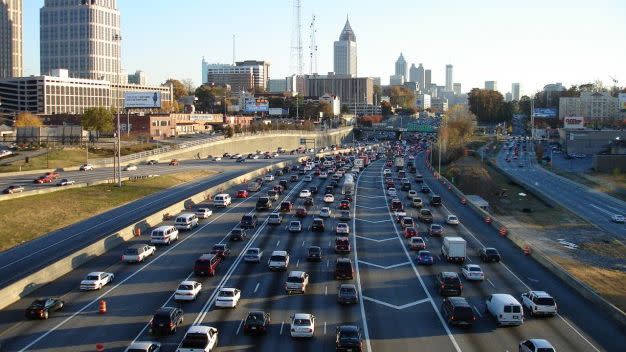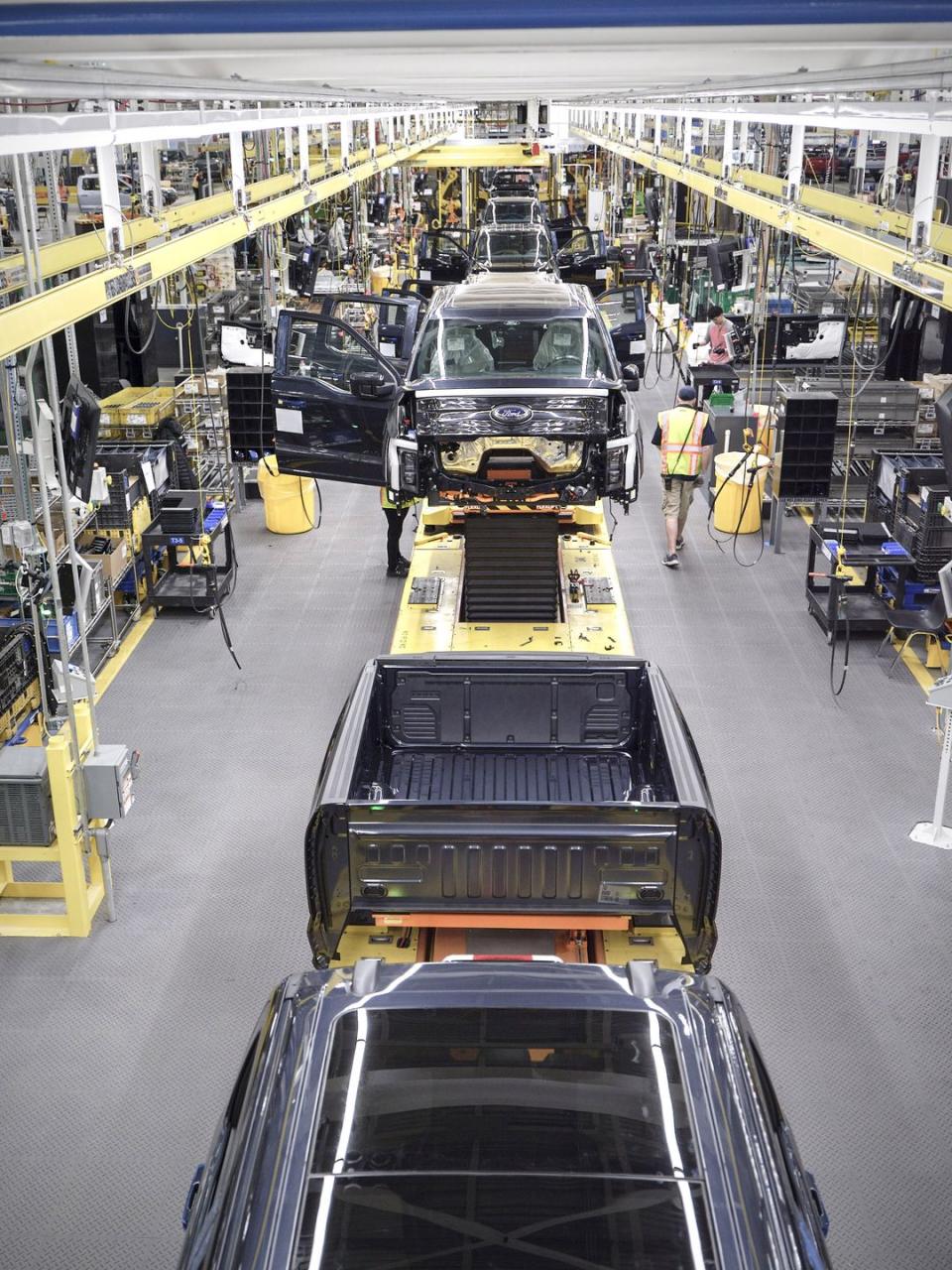Feds Tighten Emissions Rules, Making Life Tougher for Gas Vehicles

The U.S. Environmental Protection Agency held a press conference at noon today, announcing updated emissions standards intended to encourage the advent of electric vehicles.
The rules will cut tailpipe emissions in half by 2055, and the EPA claimed that they would also help the average driver in the U.S. to save $6000 in fuel and maintenance costs over the life of their vehicle.
The announcement was met with criticism from some quarters, including accusations from a petroleum-industry group that it is "Biden's EPA car ban."
Today, the EPA announced its final rules regulating national pollution standards for model year 2027–2032 cars and trucks. The updated rule will cut tailpipe pollution almost in half during that period by requiring carbon emissions to be reduced by more than seven billion metric tons. The final rule sets a tailpipe emission standard of about 80 grams per mile in 2032, half as much as the standard would be if the 2026 standards were simply extended. The EPA said the new pollution rules will reduce cumulative carbon dioxide (CO2) emissions by 7.2 billion metric tons by 2055.
Despite groups calling the new rules a "car ban," the EPA's new rules do not ban any vehicles. They don't even set specific targets for EV sales, according to White House climate policy advisor Ali Zaidi.
"The way these rules work, they are technology neutral, which means that different automakers will approach them in different ways, harnessing a variety of technologies to meet that target of reducing emissions in half over that period of time," Zaidi told Car and Driver. "What you literally find in the rule is that there are different ways that automakers could comply with the rules. For example, some automakers in 2032 could potentially make a third of their fleet be plug-in-hybrid vehicles, a third be battery-electric, and the rest be a variety of internal-combustion-engine vehicles. [There are] a number of technology tools and choices available to automakers, and I think that's gonna get reflected in the market."

A Three-Year Gestation Period
The new rules have been in the works for almost three years. Zaidi said the EPA learned a lot during the public comment period after releasing the proposed rules in the spring of 2023, especially regarding the challenges of ramping up domestic manufacturing capacity and developing new supply chains for cleaner vehicles, all the way down to cathodes and anodes for EVs, he said.
"I think EPA took all that into account in structuring a rule that is more flexible on the front end, and as a result, more readily accommodates or facilitates the scale-up of that U.S. manufacturing capability," Zaidi told Car and Driver. "The end product here is a set of standards that actually firms up our footing to not only reach our climate objectives but to continue and expand U.S. manufacturing capacity in this space and the jobs that come with it."
The EPA cited health and economic benefits as the reasons for implementing the new rules. The EPA estimated that, compared to where the U.S. would be in 2055 without these rules, there would be 8,700 fewer tons of particulate matter, 36,000 fewer tons of nitrogen oxides and 150,000 fewer tons of volatile organic compounds in our environment. These changes will provide $13 billion in annual health benefits, the EPA estimated.
For individual drivers, the tighter emissions standards will save drivers of 2027–2032 model vehicles an estimated $6000 in reduced fuel and maintenance costs over the life of the vehicle, compared to keeping the 2026 standards in place. Overall, with a $62 billion expected reduction in annual fuel and maintenance costs, the EPA estimates that new emissions rules will provide "nearly $100 billion of annual net benefits to society."
What Is the New CAFE Standard? TBA
If you're reading this article and waiting for details on the more commonly used CAFE miles-per-gallon fuel-economy targets, they were not announced today. These standards are promulgated by the National Highway Traffic Safety Administration (NHTSA), not the EPA, and analysts expect NHTSA to announce its updated MPG targets later this summer.
In July 2023, NHTSA announced its proposal for updated CAFE standards for model year 2027–2032 vehicles that would require an industry fleet-wide average of around 58 miles per gallon for passenger cars and light trucks in model year 2032. This would be accomplished, NHTSA said, by requiring passenger cars to increase their average fuel economy 2 percent year over year, while light-duty trucks would need to improve by 4 percent year over year.
Reaction from around the Automotive World
The auto industry's immediate response to the EPA's final rules was generally positive, if cautious. Automakers fought for a more relaxed runway to achieve some of the toughest targets, seeing it as a way forward that would allow the industry more time to build new vehicle infrastructure and allow the market for alternative vehicles to develop.
"GM supports the goals of the EPA's final rule and its intention to significantly reduce emissions,” General Motors said in a statement. "Although challenging, we believe our commitments and investments in an all-electric future place GM in an excellent position to contribute to the goals."
Stellantis called the later-year targets "aggressive" but said, "The final rule improves on the proposal by better reflecting the expected trajectory of market demand and enabling infrastructure."
Honda reaffirmed its commitment to carbon neutrality across its products and operations and said it "cannot overstate the importance of workable policies that support and accelerate consumer adoption of cleaner vehicles. From consumer incentives to expanding EV charging infrastructure, support from all stakeholders will be essential for the transition to zero-emission vehicles to be a success."
John Bozzella, president and CEO of the Alliance for Automotive Innovation, said the pace of EV growth matters, and he was glad to see the rules were mindful of the importance of choice.
"Moderating the pace of EV adoption in 2027, 2028, 2029, and 2030 was the right call because it prioritizes more reasonable electrification targets in the next few very critical years of the EV transition," Bozzella said in a statement. "These adjusted EV targets—still a stretch goal—should give the market and supply chains a chance to catch up. It buys some time for more public charging to come online and the industrial incentives and policies of the Inflation Reduction Act to do their thing."
Volkswagen gave C/D a statement that it said is "in line" with that of the Alliance: "We are glad that the EPA has arrived at a Final Multi-Pollutant Rule. This rule is the most significant carbon reduction plan ever for the U.S. It preserves consumer choice for models like PHEVs and reflects a more realistic pace for the adoption of EVs.
"Volkswagen is committed to electrification and is making massive investments to achieve sustainable mobility that include expanding the charging infrastructure in North America and making EVs more affordable for all.
"We hope NHTSA follows with more reasonable ICE fuel economy standards than originally proposed, as it is counter-productive to divert finite resources from electrification to a technology that has a finite shelf life. Like all other OEMs, we would like to see alignment between the Federal agencies so that companies can plan for future success."
The United Auto Workers, which endorsed President Biden in the upcoming campaign after he became the first President to walk a picket line with striking workers, approved of how the EPA reacted to public comments last year.
"By taking seriously the concerns of workers and communities, the EPA has come a long way to create a more feasible emissions rule that protects workers building ICE vehicles while providing a path forward for automakers to implement the full range of automotive technologies to reduce emissions," the UAW said in a statement.
Toyota agreed that the best way to reduce carbon emissions would be to give consumers "a variety of choices" when it comes to powertrain options, including EVs, hydrogen car, plug-in and standard hybrids as well as traditional gas models. But it had harsher words for the EPA’s strategy.
"The EPA's regulatory mandate requires a precipitous shift from around 8 percent market share of battery electric vehicles today to more than half by 2032, an aggressive, sixfold increase over just eight years," the company said in a statement. "Toyota will continue to lead the industry and comply with regulations, but serious challenges around affordability, charging infrastructure, and supply chain will need to be addressed before this mandate is realized. Ultimately, the American consumer drives the auto business."
Stakeholder groups also signaled support for or disapproval of the final rule. The Consumer Energy Alliance, for example, said in a statement that the EPA’s new passenger vehicle standards would force "an unworkable, expensive EV quota on working-class families" before falsely stating that EV sales "are actually on the decline." While EV sales in the U.S. recently dropped below analyst predictions, the numbers are still increasing.
Andre Delattre, senior vice president of the nonpartisan public interest group U.S. PIRG Education Fund, said in a statement that "Today’s consumers can choose from multiple models of clean, reliable electric cars that don’t pollute the air or require trips to the gas station. This new rule will help us realize the promise of modern vehicle technology to bring about a safer, healthier and more secure America."
You Might Also Like

 Yahoo Autos
Yahoo Autos 